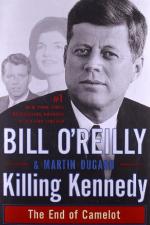|
This section contains 672 words (approx. 2 pages at 400 words per page) |

|
Killing Kennedy: The End of Camelot Summary & Study Guide Description
Killing Kennedy: The End of Camelot Summary & Study Guide includes comprehensive information and analysis to help you understand the book. This study guide contains the following sections:
This detailed literature summary also contains Topics for Discussion on Killing Kennedy: The End of Camelot by Bill O'Reilly (commentator).
Bill O'Reilly and Martin Dugard are the authors of "Killing Kennedy: The End of Camelot." The book details the rise and fall of John F, Kennedy, a man considered to be perhaps one of the most influential and well-loved presidents in American history.
The prologue begins with John Fitzgerald Kennedy (JFK) being sworn into office as the President of the United States. Kennedy is the youngest president to ever be inaugurated. JFK is adored by millions of Americans despite his thick accent and privileged upbringing. JFK knows how to relate to people of all classes and ages. Additionally, JFK's wife, the beautiful and intelligent Jacqueline Bouvier Kennedy, is his number one supporter and, many believe, the reason he received many more votes than was ever expected of the young upstart from Massachusetts.
Meanwhile, in the Soviet Union, a man named Lee Harvey Oswald toils throughout his daily life as a nobody. Oswald, a former Marine, had defected to the Soviet Union.
Kennedy's history as a naval commander is detailed, including his near fatal experiences aboard PT-109, a boat that was sunk in the Pacific by a Japanese Express ship, its survivors believed to be dead.
There are many instances in which Kennedy cheated death, from the experiences aboard PT-109 to many health issues that once put him into a coma. Kennedy also faced the death of his brother Joe, a celebrated war hero. The authors believe that these experiences led JFK to have a fatalistic outlook on life and perhaps made him somewhat careless in his politic and private matters.
The life of Lee Harvey Oswald is integral to the story. Lee Harvey Oswald is the man who would shoot and kill JFK from the sixth story window of the Texas School Book Depository. Oswald was a former Marine that had strong socialist beliefs. Oswald was so devoted to his Communist leanings that he defected to Russia. Once in Russia, Oswald learned that the system was not as idyllic as he had hoped.
Oswald was a loner, a fanatic, and most certainly unhinged. He became obsessed with Communism and spent the majority of his time reading Communist magazines. Oswald also became fascinated with guns. The story of Oswald runs parallel to that of Kennedy and his family.
The story follows Kennedy from 1961 up until his death on November 23, 1963. Kennedy had a great many trials while in office, including the disastrous Bay of Pigs invasion of Cuba. Kennedy, with the help of his brother and right hand man, Robert, fought hard to maintain good standing in the eyes of the American public. Although Kennedy faced great pressures in the Oval Office, he always found time to indulge in a vast number of extra marital affairs with almost anyone from staff to Jackie's friends to the troubled starlet Marilyn Monroe.
Oswald became aware of Kennedy as it became clear the president was anti-communist. This offended Oswald who believed that communism was the way all political systems should operate. This belief did not change when Oswald returned to America.
Kennedy had his eyes set on his re-election campaign in 1963. Recent turbulence with Jackie, plus the recent death of their son, Patrick, brought the couple closer together than ever before JFK begged Jackie to return home to join him in his Texas campaign.
Texas was known for being a state of hatred when it came to JFK. The president was warned to stay out of the state, and particularly Dallas but he would not back down from a challenge. JFK was convinced that he could win over the people just as he had in Montana.
Lee Harvey Oswald had other plans. JFK was shot and killed by Oswald as the presidential motorcade travelled through the streets of Dallas. The idea of a conspiracy theory to kill Kennedy is momentarily addressed.
Oswald, in turn, was gunned down by Dallas native Jack Ruby.
In January 1964, Jackie moved out of the White House and bade farewell to the people of America, thus ending Camelot forever.
Read more from the Study Guide
|
This section contains 672 words (approx. 2 pages at 400 words per page) |

|



